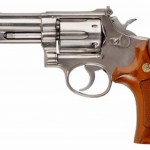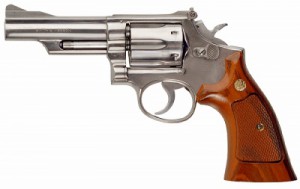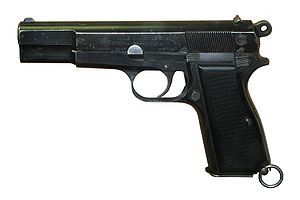Weaponry 101: Handguns
Summary
 I’ll be honest from the get-go; guns aren’t my thing. Yes they are incredibly useful distance weapons and we all know that you don’t want to get in biting range of a zombie, but guns are also loud. They draw unwanted attention. Not to mention without training and practice, are more of a hindrance than help. This isn’t the movies. You aren’t going to be able to pick up a discarded handgun, then blast your way through a zombie horde. At best you might catch one good shot before exhausting what’s in the magazine.
I’ll be honest from the get-go; guns aren’t my thing. Yes they are incredibly useful distance weapons and we all know that you don’t want to get in biting range of a zombie, but guns are also loud. They draw unwanted attention. Not to mention without training and practice, are more of a hindrance than help. This isn’t the movies. You aren’t going to be able to pick up a discarded handgun, then blast your way through a zombie horde. At best you might catch one good shot before exhausting what’s in the magazine.
Instructor: R. C. Murphy
 I’ll be honest from the get-go; guns aren’t my thing. Yes they are incredibly useful distance weapons and we all know that you don’t want to get in biting range of a zombie, but guns are also loud. They draw unwanted attention. Not to mention without training and practice, are more of a hindrance than help. This isn’t the movies. You aren’t going to be able to pick up a discarded handgun, then blast your way through a zombie horde. At best you might catch one good shot before exhausting what’s in the magazine.
I’ll be honest from the get-go; guns aren’t my thing. Yes they are incredibly useful distance weapons and we all know that you don’t want to get in biting range of a zombie, but guns are also loud. They draw unwanted attention. Not to mention without training and practice, are more of a hindrance than help. This isn’t the movies. You aren’t going to be able to pick up a discarded handgun, then blast your way through a zombie horde. At best you might catch one good shot before exhausting what’s in the magazine.
Nevertheless, handguns do serve a purpose and we at the Zombie Survival Crew strive to make sure that you are prepared for anything that’ll come your way during the Zombiepocalypse.
During this lesson, we will take a look at a few types of handguns and cover their specs. It’s important to know your weapons on the off chance you do stumble across one. Knowing where the safety is on a semi-automatic pistol could save your life. Just sayin’…
First up, revolvers. Honestly, these are as basic as a handgun can get with very little to remember on the How-To end of things. Since this is a crash-course, we won’t delve into the differences between single-action and double-action revolvers. Any revolver you encounter is likely to be double-action anyways. This means that the gun has no safety to disengage, but the first shot you take (without cocking/pulling the hammer back) will require quite a bit of effort. Each subsequent shot will be easier, but remember, with most revolvers you only get six shots before you must reload.
That doesn’t leave a lot of room for error or squeamishness. If you’ve acquired a revolver to use against the undead, make each and every shot count. Reloading without a speed loader is time-consuming and almost impossible to do with shaking/bloody hands. I’d suggest saving your revolver for a backup or last-ditch weapon should you find yourself in a bind.
Below are notes on a pair of revolvers. You will notice that they are very similar with only a few differences in weight and manufacturing.
Gun specs-
- Smith and Wesson M66:
- Cylinder capacity: 6 rounds- .357 magnum cartridge
- Double action. Reliable. Light enough for comfortable carry.
- Flaws: LOUD. Draws attention. May kick too much for untrained shooters. Preferred police revolver (though most have opted for a semi-auto pistol now, leaving the S&W as a backup weapon).
- Colt Python:
- Cylinder capacity: 6 rounds- .357 magnum cartridge
- Boasts a smooth trigger pull, accuracy, and is a double-action.
- Flaws: Cylinder misalignment after heavy shooting poses possible injury from burning gunpowder or cause gun to misfire when used in double action capacity (opposed to cocking the hammer back on the first shot). HEAVY compared to other pistols.
Now we’ll move on to the semi-automatic pistols. There are about five billion different breeds of these handguns, I’m sure of it. Each manufacturer has their own way to load a magazine, disengage the safety mechanism… you name it and they’ve strived to make it unique to their brand of guns. I’ll try my best to cover some of the basics.
The main difference you are going to see between semi-autos is the safety. Older pistols and civilian weapons have an external safety, which must be disengaged in order to fire the gun. The most likely place for the safety is on the rear of the gun where your right thumb can easily maneuver the mechanism. However, there is a new trend with semi-automatics that bypasses the safety altogether. These newer weapons, used by police and the like, use a double-action system similar to the revolvers we learned about moments ago. They possess a harder trigger pull for the first shot, with a normal pull for each shot after that. To be on the safe side, look for a safety first. If it’s not there, aim at the nearest zombie and fire.
 Semi-auto pistols carry more cartridges. That being said, you should still pick and chose your shots wisely. The sound of a gun being fired carries really far and attracts unwanted and hungry attention. Also, just because you have more chances doesn’t mean your aim will magically get better while unloading your magazine into a horde of the undead.
Semi-auto pistols carry more cartridges. That being said, you should still pick and chose your shots wisely. The sound of a gun being fired carries really far and attracts unwanted and hungry attention. Also, just because you have more chances doesn’t mean your aim will magically get better while unloading your magazine into a horde of the undead.
Gun specs-
- Browning 9mm Hi-power:
- Magazine hold: 13 rounds (14 if 1 round chambered)
- Based on single-action design. May be carried with the hammer cocked & safety on (cocked & locked) without risk of misfire. Otherwise the pistol must be cocked manually by thumbing the hammer back or pulling the slide rearward & releasing.
- Flaws: Standard trigger pull is heavy without modifications to the magazine safety (voiding warranty). The hammer has a tendency to “bite”, pinch between thumb and forefinger with the hammer spur. Some replace the hammer to a smaller design or relearn how to grip this specific gun to avoid injury.
- Beretta 92FS 9mm:
- Magazine hold: varies (10,15,18,20) typical: 15
- Uses a double-action first trigger pull with single-action pull for subsequent rounds. Open slide prevents jamming.
- Flaws: Weight and size may be an issue for smaller hands. Cannot carry cocked & locked. Long trigger pull is deterrent for some. Not much stopping power with the 9mm (compared to .40 & .45 without ammo upgrade).
- Heckler & Koch P30 9mm or .40 S&W:
- Magazine hold: 13 rounds (.40 S&W) 15 rounds (9mm)
- Double action first shot (approx. 10 pounds of pressure on the pull), subsequent shots are single action (approx. 5 pounds of trigger pull). No external safety. Decocking is done via a button near the hammer.
- Flaws: The hard first pull seems to be a detractor, but designers consider it integral to prevent accidental firing during a struggle.
That’s it for the lesson on handgun basics. If you have anything to add on that I’ve over looked, please leave a comment and share with the class.
Remember, if you are going to be serious about learning how to use a handgun, do it responsibly and safely.

Not a bad article. However, there are a few mistakes.
A double action revolver’s trigger pull does not get lighter with subsequent pulls. Each pull is identical, having to move the cylinder the same diameter to the next chamber, and having to pull the hammer the same distance back. The action relies purely on the shooter delivering mechanical leverage via the trigger to operate.
Double Action/Single Action Autoloaders may have been what you were thinking of, as they start with a longer, heavier pull, then the slide cocks the hammer on each shot, resulting in lighter subsequent shots. This is what you referred to in the newer semi-auto pistols section. This is common on newer military issue handguns such as the Beretta 92/M9 and Sig Sauer handguns.
However, many new pistols use a modified double action system (like GLOCK, S&W, Springfield Armory, and many of H&K and Sig’s Double Action Only systems) that produce an identical trigger pull with each shot, some being under 4 pounds (such as the Glock series 3.5-pound trigger connector, which is a common aftermarket addition, and a stock feature on their long slide competition models).